I’m sitting by a pond with musician Cosmo Sheldrake, wearing a pair of headphones that are attached to a large, fluffy microphone a few feet away. An obstacle course of wires surrounds us and there are two more microphones hidden in a bush by a bird feeder. It looks like lockdown’s answer to a silent disco, but far from being engrossed in techno music we’re soaking up natural sounds performed by the birds of the dawn chorus.
This is how Sheldrake has started many mornings since the Covid-19 pandemic began, in an off-grid cottage hidden in woods outside the New Forest near Fordingbridge in Hampshire. He has just made an album of avian conversations called Wake Up Calls and today he is showing me how he makes his wild recordings. I arrive at 6.30am to hear the moment howling owls sign off and pass over to songbirds making their morning announcements.
Through the headphones, drizzle on the water sounds like a monsoon and a screeching blackbird sounds as if it’s sitting on my shoulder. Listening to the plucky protagonist is a reminder that this morning ritual is a fight for survival – males are serenading females but also warning others to keep off their patch. The Good Life is not all about joie de vivre.
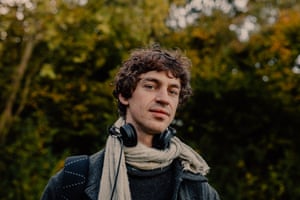
-
‘When you slow birdsong down, you get an idea of the tapestry of what they’re saying’ – Cosmo Sheldrake. Photograph: Peter Flude/The Guardian
The whitewashed cottage belongs to Sheldrake’s girlfriend’s mother and when she started renting it 36 years ago there was a tree growing through the kitchen. The week before my visit an oak nearly crushed the shepherd’s hut (transformed into an office). Sheldrake is as eccentric as you’d expect, given that he is the son of the maverick biologist Rupert, and brother to fungi expert Merlin. Musically, he is most influenced by his mother, Jill Purce, who teaches and practises Mongolian overtone chanting.
On the walls inside the cottage is a kaleidoscope of paintings, mainly depicting views from around the house (his girlfriend’s mother is the artist Lizzie Wallace). Sheldrake, who is normally London-based, doesn’t drive so it’s convenient that his source of inspiration comes from the woods hugging the house. These paintings are a visual reflection of the landscape, while Sheldrake’s album is a reflection of the noises it makes.
His studio-cum-field-station is a metre from a bird feeder. Inside the studio is a bed, an armchair and a scruffy collection of boxes. He puts the sound recordings into his computer and slows down individual calls. It’s like intercepting morse code, revealing delicate cadences you don’t hear when the songs are rattled out at speed. The blackbird is a guttural, gritty character, while the robin’s voice has bell-like purity.
“Birds live on a different time axis,” says 30-year-old Sheldrake. “There’s a spectrum of relationships with time – we look at birds and think they’re very ‘other’, but when you slow their song down, you get an idea of the tapestry of what they’re saying and they sound strangely human. These are very subtle, integrated phrases that we miss when they’re singing at their normal speed.”
And so these little characters and conversations have been pieced together in an album that follows the natural acoustics of the day; it starts with a nightjar, which sings just after dusk and through the night, then goes to a nightingale, and then the dawn chorus, before working its way through the day. A chord can be composed of five or six different aspects of a song played simultaneously. Tracks are based on sounds that already exist and have their own identity and character. “It’s a collaboration,” says Sheldrake, “except without explicit consent from the birds.”
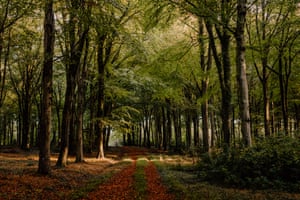
-
Beech woodland where the cottage can be found in Hampshire. Photograph: Peter Flude/The Guardian
At first, Sheldrake made songs as Christmas presents for friends and family to use as alarm clocks. People who got them then found they couldn’t sleep through the actual dawn chorus because they had tuned into it. Sheldrake wanted more people to be conscious of bird sounds so he decided to make an album.
“Once you can identify them as species or individuals, it just turns into this completely insane conversation across huge amounts of time and space,” says Sheldrake. “You have these themes essentially rippling through the woods. Everything that happens in a woodland is like a stone dropping into a pond. It sends out these ripples as those birds respond and then respond to those responses … there are so many layers and levels to it,” he says.
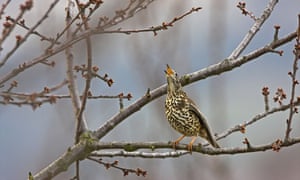
-
A mistle thrush, which is widespread in the UK but was added to the red list of endangered species in 2015. Photograph: blickwinkel/Alamy
Part of his aim is to highlight how we may not be conscious of the loss of wildlife from our lives. Many of the birds featured on his album, such as marsh warbler, mistle thrush and dunnock, are no longer a ubiquitous part of our soundscapes. The star performers from today’s chorus – blackbirds and robins – didn’t make it on to Sheldrake’s album because they are not (yet) on the red or amber list of endangered British birds.
We go on a sonic field trip in the forest around the house, walking through old plantations – the beech woodland, with its dark canopy and little plant growth on the forest floor, sounds like a cathedral. Sheldrake describes it as a “slow, crashing surf sound, like an ocean”. The ash – blighted with dieback – has little canopy to hold sound in. Poplars have a “rushing, sucking sound”.
Within these forest environments, sound is a critical method of communication. Birds have evolved acoustic as well as physical niches – and they use different frequencies and rhythms so they can still identify individuals. Historically, the sonic landscape has been underrepresented in research, but a new wave of acoustic ecologists are paying more attention to sound, led by the US musician and soundscape ecologist Dr Bernie Krause. Listening to the voices of the natural world propels that experience into another dimension, says Krause.
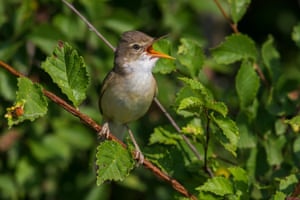
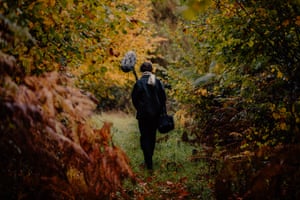

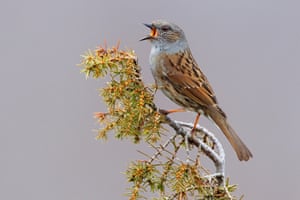
-
The red-listed marsh warbler (top left) and amber-listed dunnock both feature on Cosmo Sheldrake’s digital album Wake Up Calls. Photographs: Buiten-Beeld/Alamy and Peter Flude/The Guardian
“It’s important to heighten our awareness of natural soundscapes and, in particular, ‘biophonies’ [the name Krause gives to sounds collectively produced by wildlife], because they convey a sense of place,” he says. “The narratives are the origins of our music and language. They speak to the health of a habitat. They tell us how we’re doing in relationship to our environment. And they can serve as analgesics in these unsettling and stressful times.”
As well as raising awareness about loss of natural sounds, Sheldrake has always liked the idea of “playing places” – playing songs back to the place they came from. He didn’t know this could potentially be beneficial until he looked at the work of Prof Steve Simpson from the University of Exeter on “sonic enrichment”, in which the sounds of healthy ocean reefs are played into degraded areas in order to attract life back to them.
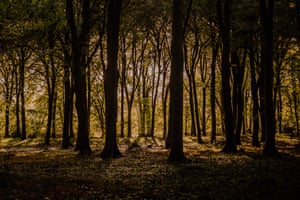
-
Within forest environments, sound is a critical method of communication – birds have evolved acoustic as well as physical niches. Photograph: Peter Flude/The Guardian
According to research published in Nature Communications last year, playing the sound of a healthy reef into a degraded and abandoned one can lure fish back to the area. Blasting “golden oldies” back on to a reef is like “putting it on steroids”, says Simpson.
It’s not known whether a similar approach might work with birds. Krause believes that playing bird sounds back into a habitat risks stressing out organisms that have already carved out an acoustic niche for themselves. Sheldrake describes it as a “romantic ideal”, and half-hopes he might lure a passing cuckoo.
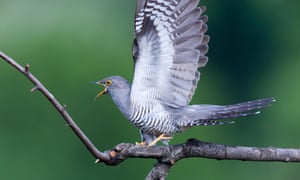
-
The common cuckoo, the only one of three cuckoo species found in Europe to visit Britain, and on the IUCN red list. Photograph: Vasiliy Vishnevskiy/Alamy
For most people, the sounds in Sheldrake’s album are already noises from a more bird-rich past. The UK has lost 90% of its nightingales in 50 years, and more than 55% of skylarks and cuckoos. There are now only 80 breeding male bitterns left.
The album is a celebration of sound but also a warning of the beauty we’re losing.
Find more age of extinction coverage here, and follow biodiversity reporters Phoebe Weston and Patrick Greenfield on Twitter for all the latest news and features